Qi Gong exercises
Introduction
What is Qi Gong?
In traditional Eastern medicine, the “Qi” is the vital energy that flows inside the body.
“Qi Gong” refers to exercises that use the breath to adjust the flow of vital energy inside the body, bringing benefits to the body, mind and inner organs and resulting in improved health and longevity.
The Qi Gong exercises described in this article were designed by Master Thích Thông Triệt to help students keep the body in good health and assist the meditation practice.
Benefits of Qi Gong
Practitioners can expect to achieve the following health benefits:
- Improved lung function: through increase in oxygen intake and carbon dioxide rejected by the body
- Improved cardio-vascular function: during the holding the breath phase, blood is pushed through the veins towards the areas where we focus our attention. During the breathing out phase, blood is pushed though the arteries, improving the blood supply to extremities (such as the skin) and inner organs, and cleansing any clogging in the arteries. Practitioners will notice the effect of improved blood supply to the face and the hands.
- Improved nervous system function: improved memory and brain function through improved blood supply to the brain. The sustained concentration during practice and the relaxation at the end of the session stimulate and balance both the sympathetic nervous system and the parasympathetic nervous system.
- Improved digestive system function: through deep breathing in and out and diaphragmatic breathing, the stomach and intestines are massaged, improving appetite and alleviating constipation.
- Improved immune system function: holding the breath and focusing the mind on lymph modes push white cells into the blood stream towards extremities and inner organs.
- Improved joints flexibility: gentle and sustained pressure on the joints improves their flexibility and strengthen the bones.
- Beneficial physiological effects: transport of beneficial biochemicals generated by the muscles to inner organs.
- Cleansing and prevention: cleansing of clogging of the arteries, improved prevention of illnesses through strengthening of the immune system, and improved elimination of toxins through improved operation of the liver.
General Principles
Breathing
- Principle: 1 – 4 – 2: Breathe In for one unit of time, Hold for four units of time, Breathe Out for two units of time.
- Breathing In: Count 1, 2, 3. Breathe in deeply through the nose, lift the diaphragm, inflate and broaden the chest.
- Holding the breath: Count 1, 2, 3, … to 12. Depending on the movement practiced, tighten the muscles in the arms, shoulders, chest, thighs and especially the armpits and the groin. Focus the attention to a specific area depending on the desired effect.
- Breathing Out: Count 1, 2, 3, … to 6. Breathe out slowly through the nose or through the mouth (your choice). Relax the whole body, relax the muscles, relax the hands, relax the legs, slightly bend down the legs where appropriate.
Practice each movement 3 to 5 times.
Key principles to keep in mind:
- Respect you natural capacity: breathe in – hold – breathe out according to your natural capacity. If you have cardio vascular issues, are prone to dizziness or are asthmatic, you may count to 1 or 2 instead of 3 when you breathe in. Likewise, hold for only as long as you are comfortable, and do not run out of breath when you breathe out. However, always maintain the ratio 1 – 4 – 2.
- Reach the top of your capacity: for experienced practitioners, extend the length of Breathing In – Hold – Breathing Out to the maximum of your capacity while maintaining the ratio 1 – 4 – 2.
Duration: Practice for 15 to 30 minutes in the morning. If you practice with the purpose of curing a specific illness, you may practice several times a day and practice only those movements that are relevant to your goal.
Focus the mind: focus the mind on pain points or energy centers.
Note: beginners should practice under the guidance of a Sunyata Qi Gong instructor.
Warm Up Movements
General warm up movements at the beginning of a session.
Swinging the arms / “Sinew Metamorphosis”
Effect: increase inner energy level, regulate cardio vascular system and lungs, improve knee joints, improve flexibility of arms and legs muscles.
Description
- Breathe normally, stand upright, the feet about shoulder-width apart
- Slowly lift the two arms in front of you no higher than shoulder level
- Swing the two arms strongly downwards
- Bend your knees as you swing the arms downwards
- Repeat the action about 50 to 100 times (or 5 to 10 minutes)
A. Standing Movements
1. Inner energy breathing
Effect: increase inner energy level, strengthen immune system. This is a key movement in Qi Gong.
Description:
- Stand upright, the feet about shoulder-width apart, the two hands clasped in front of you
- Breathe In: Keep your two arms tight against your armpits
- Hold: tighten the tummy, clasp the two hands tight, strongly tighten the muscles in the arms, shoulders, body and legs, and press the arms hard against the armpits. Focus the mind on the dan-tien energy center (about 8cm below the navel)
- Breathe Out: slowly relax all muscles, loosen the knees, relax the body, and go back to the initial position.
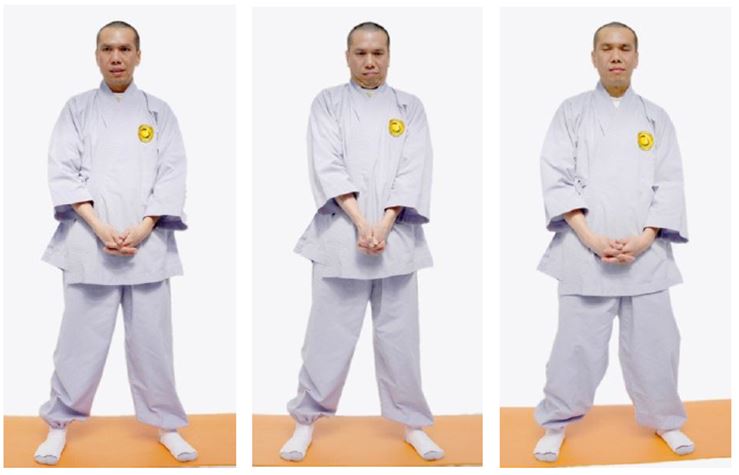
2. Breathing into the aorta artery
Effect: prevent and alleviate clogging of the aorta
Description:
- Stand upright, the feet about shoulder-width apart
- Breathe In: slowly lift your left arm, keep it tight against the head, the back of the hand facing out (left), the right arm dangling alongside the body
- Hold: tighten the left side of the body, the left arm and left hand. Lean the whole body to the right to tighten further. Focus the mind on the left hip.
- Breathe Out: relax, slowly bring the left arm down, and go back to the starting position.
- Change arm and repeat
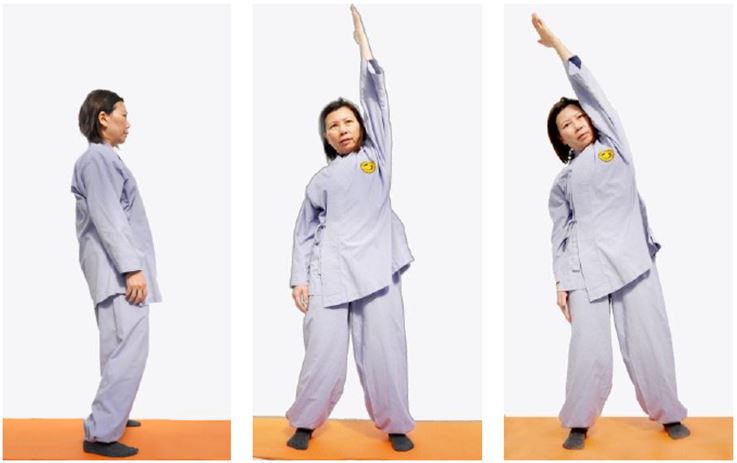
3. Breathing into the heart
Effect: prevent and alleviate cardio vascular problems
Description:
- Stand upright, the feet about shoulder-width apart, the two arms dangling alongside the body
- Breathe In: slowly bring the two hands to about shoulder height, lean the upper body backwards
- Hold: widen the diaphragm, tighten the chest around the heart. Focus the mind on the heart.
- Breathe Out: relax, slowly bring the arms down, and go back to the starting position
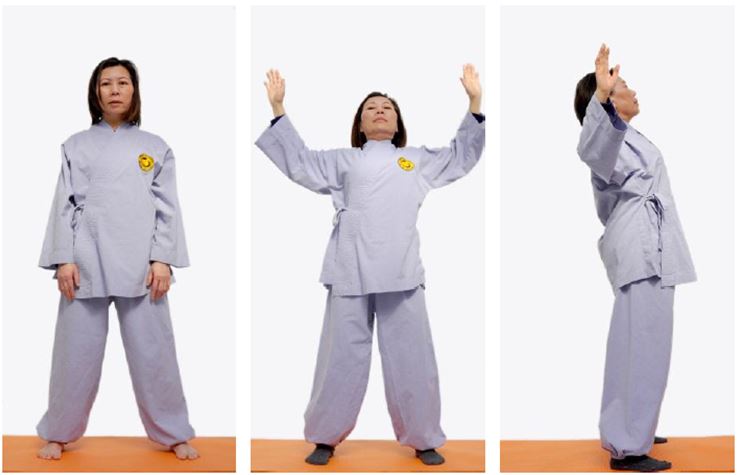
4. Breathing into the kidneys
Effect: strengthen the kidneys, reduce back pain, reduce incontinence, reduce hair loss and balding
Description:
- Stand upright, the feet about shoulder-width apart
- Breathe In: place the two hands on the waist, press the thumbs onto the back of the waist where the kidneys are located
- Hold: Bend the upper body backwards. Tighten the muscles around the waist. Focus the mind on the kidneys.
- Breathe Out: relax, slowly straighten the body, and go back to the starting position. (If you feel dizzy, do so very slowly).
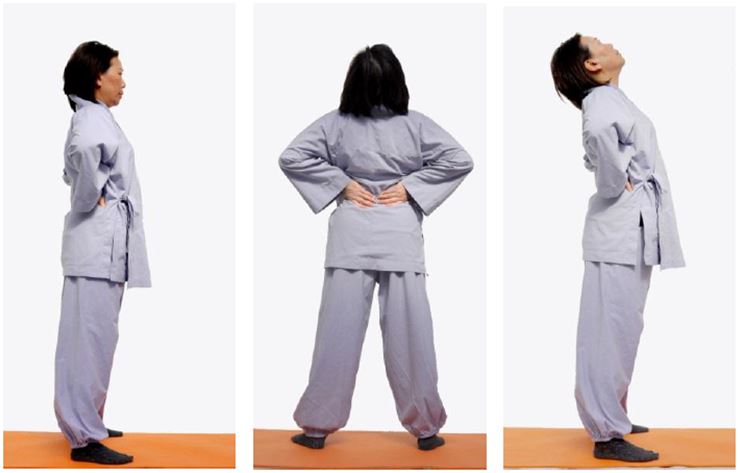
5. Strengthening the joints
Effect: strengthen ligaments and tendons, increase fluids in knee joint, reduce joint inflammation
Description:
- Stand upright, the feet about should-width apart
- Breathe In: bring the left leg diagonally forward, keep the right leg in the same position
- Hold: slowly bend the left knee down as far as possible, tighten the left leg, keep the right leg straight, bring the left arm up to about the level of the eyes, move the right arm back about a hand-span and pointing towards the ground. Keep the body upright. Focus the mind on the left knee.
- Breathe Out: slowly straighten up the knee, relax all muscles, and go back to the initial position
- Change leg and repeat
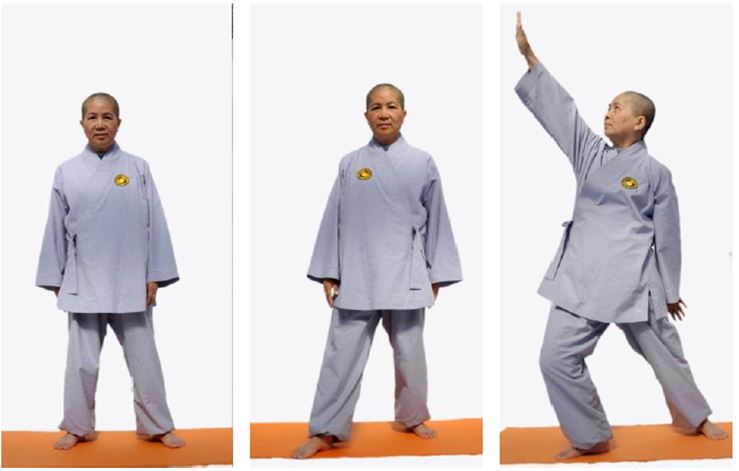
B. SITTING MOVEMENTS
6. Breathing into the knees, thigh muscles and ligaments
Effect: reduce pain in the spine, increase flexibility of the knee joint, thigh muscles and ligaments
Description:
- Sit on the floor, the two feet joined together, the two knees horizontal, ideally touching the ground, the back straight
- Breathe In: Hold the toes with the two hands
- Hold: slowly bend the upper body down, keep the back straight, bring the face as closed to the ground as possible, tighten the thigh muscles and ligaments. Focus the mind on areas where is some pain.
- Breathe Out: slowly straighten up the upper body, and go back to the initial position
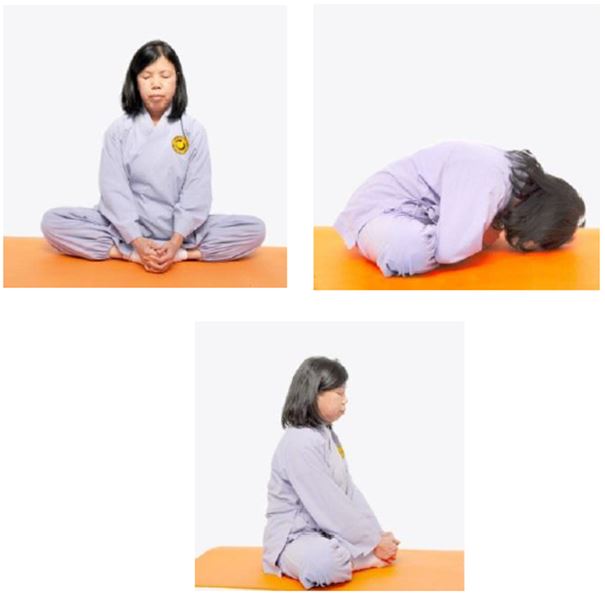
7. Breathing into the thymus gland, strengthening the immune system
Effect: strengthen immune system, prevent cancers
Description:
- Sit crossed-legs, the back straight
- Breathe In: close the two fists, place them in front touching the ground, the back of the hands facing forward, like a sitting lion. The two fists are close, so that the two arms pressed against the armpits.
- Hold: tighten the arm muscles, lift the face towards the ceiling, push the chest out, tighten the chest muscles around of the thymus (behind the sternum). Focus the mind on the thymus.
- Breathe Out: slowly relax the whole body, and go back to the initial position.
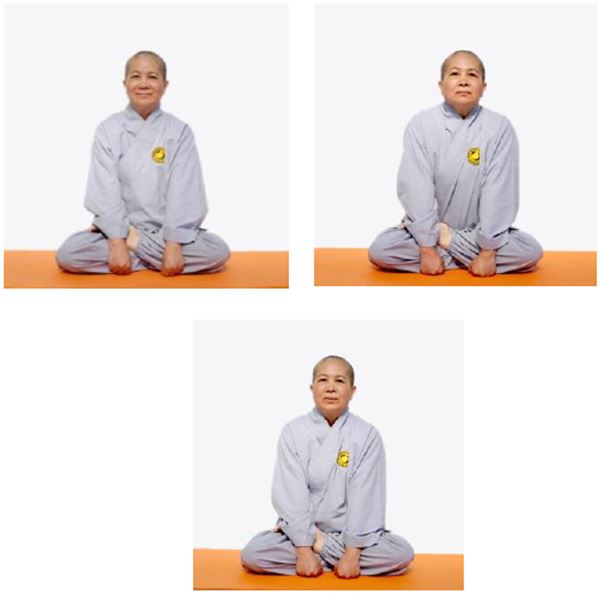
8. Breathing into thigh muscles
Effect: reduce pain in the thigh muscles
Description:
- Sit cross legged, extend left leg forward at a 45 degree angle, keep right leg in place
- Breathe In: extend the left arm and touch the left foot (same side), extend the right arm backwards
- Hold: tighten the left thigh muscles, keeping the knee pit on the ground. Focus the mind on the left posterior thigh muscles (hamstrings) where the thigh touches the ground.
- Breathe Out: relax the whole body, and go back to the initial position
- Next: keep the left leg extended, do the same movement but with the right arm touching the left foot (arm and leg crossing over).
- Change leg and repeat
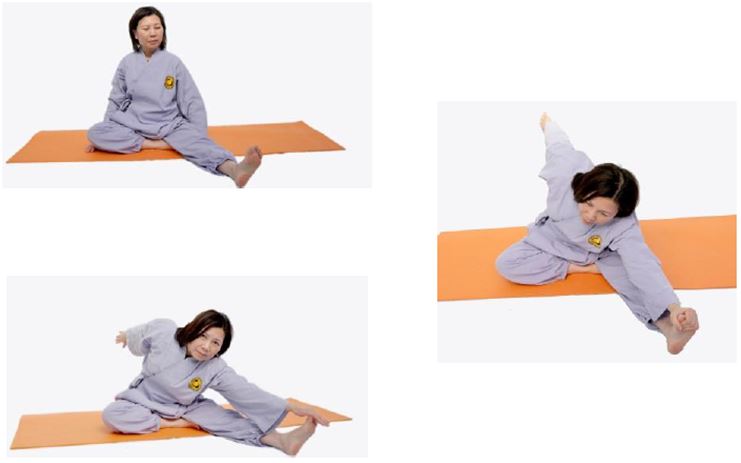
9. Breathing and improving face skin
Effect: improve the health of face skin, prevent illnesses affecting the eyes, nose, ears and face skin.
Description:
- kneel and sit on the two ankles, keep the back straight
- Breathe In: join the two hands at the back, one hand holding the other arm’s wrist
- Hold: pull the tummy in, tighten the two arms pressing onto the armpits, and slowly bend the upper body down so that the head touches the ground (if possible). Focus the mind on the face (the skin).
- Breathe Out: slowly bring the body back up, and go back to the initial position.
- Note: if you have a runny nose or a cough, you may focus the mind on the nose or the throat. If you have some issue with the ears, you may tighten the area around the ears and focus the mind on the ears. If you have high or low blood pressure, or if you easily feel dizzy, you need to be careful when you practice this movement, and stop if you feel dazed.
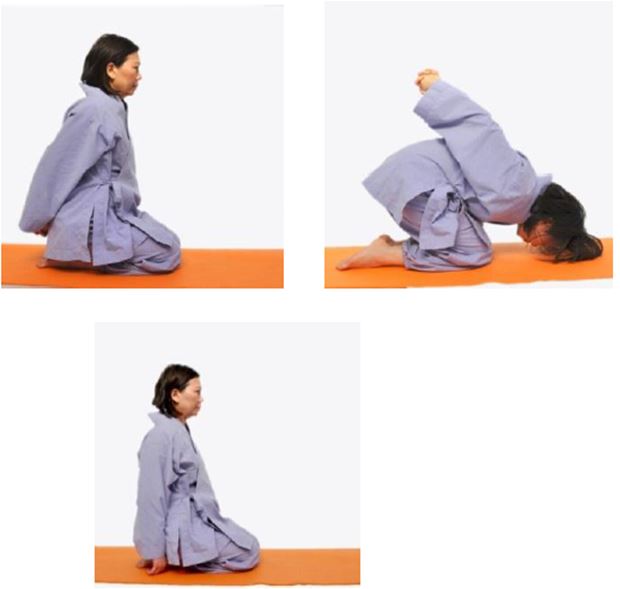
B. LYING MOVEMENTS
10. Breathing into the sciatic nerve
Effect: prevent and alleviate pain in the sciatic nerve.
Description:
- Lie on the back, the two arms on the ground at right angle to the body
- Breathe In: Lift the left leg vertically, keep the right leg touching the ground.
- Hold: bring the left leg towards the right, turn the head to the left (opposite side to the leg), keep the shoulders on the ground, tighten the left leg. Focus the mind on where there is some tension in the sciatic nerve.
- Breathe Out: slowly bring the left leg back up and then down towards the initial position.
- Change leg and repeat.
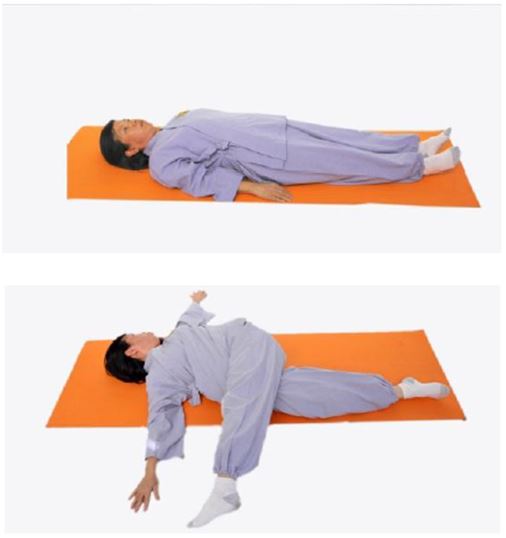
11. Breathing into the liver
Effect: strengthen the liver.
Description:
- Lie on the back, the legs straight
- Breathe In: put the two hands on the tummy, cross the fingers, tighten the left big toe and point it upward, tighten the right big toe and press it down on the left big toe.
- Hold: lift the head and the two joined feet about 20cms off the ground, press the two toes hard onto each other. Tighten the muscles around the waist. Focus the mind on the liver (upper area of the tummy, on the right hand side)
- Breathe Out: slowly put the legs down, and go back to the initial position.
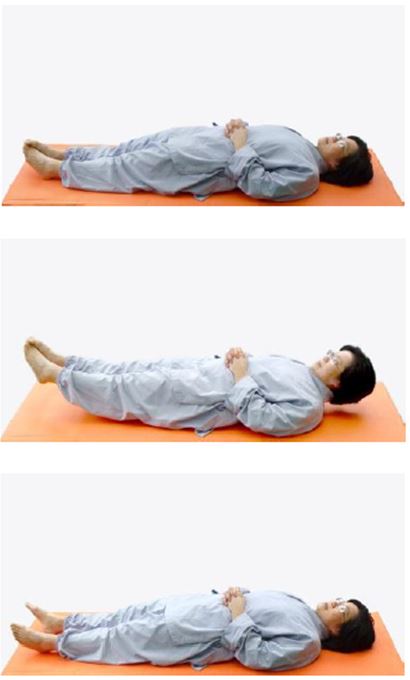
12. Breathing and strengthening nervous system
Effect: strengthen nervous system, alleviate fear of ghosts, vague fears.
Description:
- Lie on the back, the knees bent, the two feet on the ground.
- Breathe In: put the two hands around the ankles, or alternatively, touch the ankles with the two hands.
- Hold: lift the buttocks as high as possible, keep the head and shoulders touching the ground, tighten the two arms and thighs. Focus the mind on the back of the neck.
- Breathe Out: slowly put the buttocks down, and go back to the initial position.
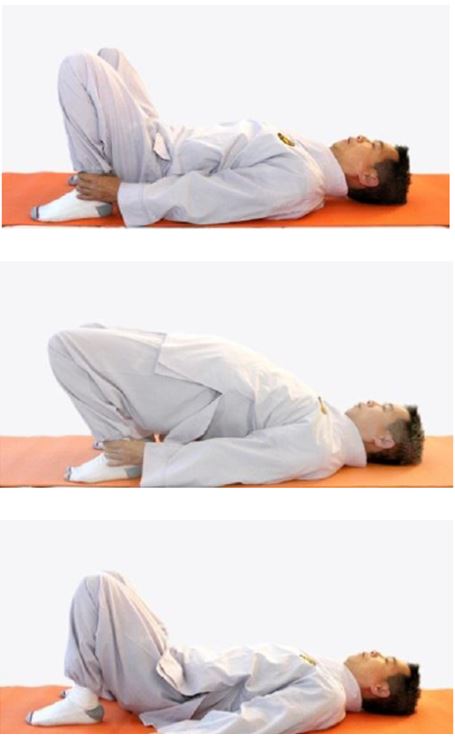
13. Breathing and bringing blood to the brain
Effect: supply blood and oxygen to the brain, nourish the brain cells.
Description:
- Lie on the back, legs extended, arms alongside the body
- Breathe In: slowly pull the two feet close to the buttocks
- Hold: pull the tummy in, tighten the two fists, bend the arms, use the fists to push the back and shoulders off the ground as high as possible. Have only the feet and the top of the head as support, point the chin towards the ceiling, keep the shoulders and the neck off the ground, tighten the two arms. Focus the mind on the top of the head.
- Breathe Out: slowly bring the back down, straighten the legs, and go back to the initial position.
- Note: if you have high blood pressure, you should be careful when you practice this movement. If you feel dizzy because the head is pointing down, you should stop and do fewer iterations.
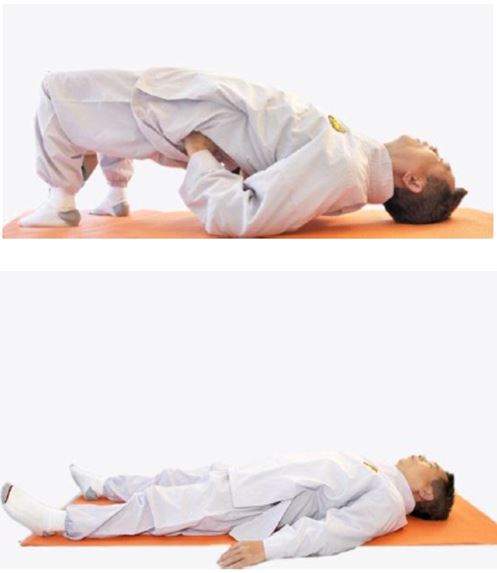
14. Relaxation
Effect: balance the production of hormones. Help produce acetylcholine to counter- balance the production of epinephrine and norepinephrine that occurred during the session.
Description: lie on the back, relax the whole body, remove the spectacles, close the eyes, face the palms towards the ceiling, keep the two arms comfortably away from the body, keep the legs straight and the feet about shoulder-width apart, let the two feet dropping naturally to the side. Breathe in and out softly and naturally. Feel as if the body is sinking into the ground. Stay at least five minutes. You may doze off.
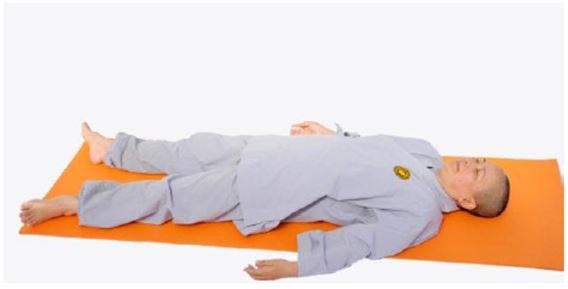
![]()